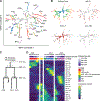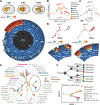A lineage-resolved molecular atlas of C. elegans embryogenesis at single-cell resolution
- PMID: 31488706
- PMCID: PMC7428862
- DOI: 10.1126/science.aax1971
A lineage-resolved molecular atlas of C. elegans embryogenesis at single-cell resolution
Abstract
Caenorhabditis elegans is an animal with few cells but a wide diversity of cell types. In this study, we characterize the molecular basis for their specification by profiling the transcriptomes of 86,024 single embryonic cells. We identify 502 terminal and preterminal cell types, mapping most single-cell transcriptomes to their exact position in C. elegans' invariant lineage. Using these annotations, we find that (i) the correlation between a cell's lineage and its transcriptome increases from middle to late gastrulation, then falls substantially as cells in the nervous system and pharynx adopt their terminal fates; (ii) multilineage priming contributes to the differentiation of sister cells at dozens of lineage branches; and (iii) most distinct lineages that produce the same anatomical cell type converge to a homogenous transcriptomic state.
Copyright © 2019 The Authors, some rights reserved; exclusive licensee American Association for the Advancement of Science. No claim to original U.S. Government Works.
Conflict of interest statement
Figures





Comment in
-
Mapping worm embryogenesis.Nat Rev Genet. 2019 Nov;20(11):630. doi: 10.1038/s41576-019-0179-2. Nat Rev Genet. 2019. PMID: 31548660 No abstract available.
References
Publication types
MeSH terms
Associated data
Grants and funding
LinkOut - more resources
Full Text Sources
Other Literature Sources
Molecular Biology Databases

